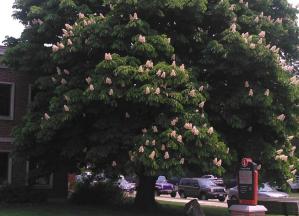Welcoming new Bengals is an important part of helping them connect with the campus, faculty and staff members, fellow students, and the community
[more...]The European or common horse chestnut (Aesculus hippocastanum) is a very large tree planted throughout eastern North America. Commonly seen in cemeteries and parks and on college campuses and golf courses, this tree needs a lot of room to grow. In the late spring and early summer, their flowers are creamy-white panicles, which start off yellowish and fade to a reddish tint. Not a true chestnut, this tree bears a spiny two-inch capsule that will produce one or rarely two conkers. The inedible conkers are often buried by squirrels, and they easily germinate and grow. Some gardeners consider this European native an invasive species because it does reproduce readily. The tree’s glossy green leaves turn from yellow to orange to bronze in autumn.
This large specimen is on the southwest corner of Moot Hall. Anne Frank described a horse chestnut tree in her diary, and this tree is dedicated to Buffalo State University’s Anne Frank Project.
_________________________________________
Photo and information courtesy of Steven Sypniewski, assistant campus planner and manager of the Buffalo State Maud Gordon Holmes Arboretum.


